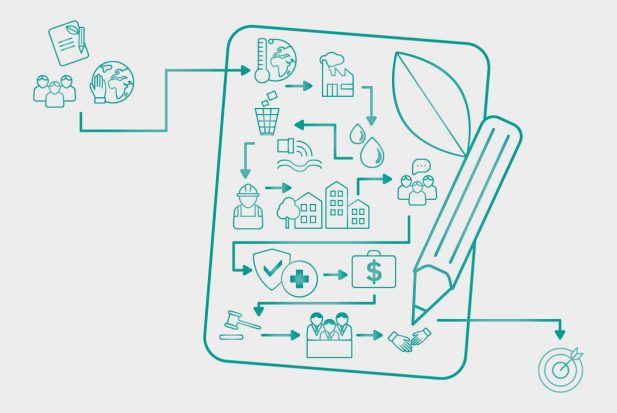
In Q1 2021, GTR hosted a roundtable discussion that brought together several industry players to examine the impact of the Covid-19 pandemic on the incorporation of ESG in trade finance, and the role that the financing community must play in ensuring that progress continues to be made.
Roundtable participants
- Marilyn Blattner-Hoyle, global head of trade finance, AIG
- Roberto Leva, trade and supply chain finance relationship manager, Asian Development Bank & co-chair ICC sustainable trade finance initiative
- Alexander Malaket, founding partner, ESG Validation & president, Opus Advisory Services International
- Shannon Manders, editorial director, GTR (moderator)
- Lisa McAuley, chief executive officer, Global Trade Professionals Alliance (GTPA)
- Annabel Ross, senior programme manager for the University of Cambridge Institute for Sustainability Leadership’s (CISL) Banking Environment Initiative (BEI)
- Surath Sengupta, global head of financial institutions, portfolio management and distribution, and sustainability, global trade and receivables finance, HSBC
- Shona Tatchell, CEO and founder, Halotrade
- Roberto Leva, ADB
- Marilyn Blattner-Hoyle, AIG
- Lisa McAuley, GTPA
- Annabel Ross, CISL
- Alexander Malaket, Opus Advisory
- Surath Sengupta, HSBC
- Shona Tatchell, Halotrade
- Shannon Manders, GTR
GTR: Far from being a ‘nice to have’ in the good times, we know now that sustainability is increasingly integral to how businesses operate. According to a recent HSBC Navigator report, businesses that prioritised sustainability felt better prepared for the current crisis – an important factor going forward, given that environmental risks are likely to intensify. But to what extent do we now have buy-in from all parties in the trade ecosystem specifically that sustainability is good business?
Sengupta: As we all know, Covid-19 has delivered a seismic shift in terms of underlining the importance of resilience in supply chains. It’s shone a spotlight on the role and responsibility of corporates to tackle environmental action, inequalities, social justice and the like. Interestingly, the observation has been that pre-pandemic, this has often been a buyer-led discussion. But what we’ve seen over the last months is that now it’s also a requirement from the smaller players, the suppliers, who are trying to work out how they transition.
In addition to this, the measure of success of a corporate has shifted significantly. Fifty years ago, the main driver of success was profit, which then gradually shifted to shareholder success. I think what has happened is that it’s now turned into an overall societal value which the corporate delivers that defines their success. This shift presents us all with a role to play because it is something that has to be done. It also presents a commercial opportunity for everybody involved.
Ross: The momentum is definitely building and we’re seeing it from all angles. I don’t think there are many parties that haven’t opened their eyes to the fact sustainability is something they need to address.
In terms of full buy-in from all trade finance players, I would suggest there is more work to be done.
Something that I would like to see develop quite rapidly is the recognition of the different roles and responsibilities that players can assume within this very complex challenge of applying sustainability to the whole trade finance ecosystem. It’ll be interesting to see what the minimum buy-in will be to really gain traction – because we don’t need 100% of the market to see the light, we need enough to be able to secure that transition over time. But this isn’t about little steps of iteration; this is a wholesale transformation and shift. It won’t only be one organisation taking the lead, but many different players coming together.
Tatchell: This is very much an ecosystem play. We have to recognise that everybody involved in the trade finance and supply chain industry all plays a very connected role.
One of the difficulties we have historically had is being able to connect across the entire supply chain. But if you disconnect players and participants at the bottom of the pyramid, at the outer reaches of the supply chain, from those at the top of the supply chain, and those who finance them, you’re never going to be able to get everybody working together in harmony, and achieving the same goals. So to me, the critical driving factor in all of this is how do we connect information? How do we bring everyone together? With that connectivity, and building that ecosystem together, how do we then incentivise the right behaviours? The problem is too big for any one participant in the global economy to be able to solve by themselves, so it has to be a joint effort. This is about collaboration. At Halotrade, as a small startup, we have to work collaboratively with everyone, and I think that could be a model of how we need supply chains and the trade system to work.
Blattner-Hoyle: Touching on that point about connectedness, at AIG, we believe that insurance, risk takers and sustainability are all interconnected. Insurance exists to protect against uncertainty, which includes environmental, social and governance practices. But risk takers can’t stand alone. We have seen some progress, for example with rating agencies incorporating ESG criteria into their ratings, which means that much of what we do already looks at ESG.
There was a recent McKinsey Global Institute report that talked about how 93% of global supply chain leaders are now planning on increasing resilience. If you think about what that resilience is in supply chains, there’s an interconnected layer with sustainability in terms of visibility, transparency and provenance. All of these pieces coming together on a connected basis can really drive meaningful change, and Annabel is right in that more can be done.
GTR: Who leads the push and the pull to better ESG performance in trade? Should this be led by regulators? What role do financiers play? What balance should be struck between carrot – a margin ratchet on supply chain finance programmes, for example, or stick – say, that banks no longer finance this activity?
Leva: Saying that the regulator should be the only ones pushing this would be dangerous. When it happened in the past, it meant that something was done incorrectly, and that the solution had to be found in a hurry. It also meant that a lot of fines had to be paid.
Having said that, there needs to be an acknowledgement from the regulators, which there has been in a number of countries, in terms of the importance of sustainability. What’s missing at this point is a holistic view. Certain regulators in various countries are focusing on specific aspects – therefore the regulatory environment still seems a bit disconnected.
The real push, in my opinion, should come from both the companies and the financial institutions. The corporate, at one end, needs to realise the importance of this, and how it links to reputation and returns.
The same thing needs to be done at the banking level to understand that this is an advantage.
Now, with regards to the carrot or stick approach, a balance between the two is always necessary. Within the ICC sustainable trade finance working group, we are evaluating whether it’s possible for regulators to consider different costs of capital requirements when it comes to sustainable transactions. It’s not an easy task, but it needs to be looked at in terms of all of the studies that have been done about ESG: do they actually have an impact on the credit rating? If you have a sustainable
business model, can you empirically prove that your business model will have longevity, and therefore reduce the risk? That could be a very good ‘carrot’ for the industry, because at the moment, anyone that applies preferential prices for sustainability does so at their own costs ultimately, reducing their returns.
When it comes to the stick, I think that’s also very important, because you need to start setting the bar. What happened a few years ago, with anti-money laundering, that bar came up very quickly, and everybody had to reach that level with great speed. There’s a good opportunity here to start establishing that bar at a reasonable pace, so that companies can adapt to it – or prove that they are already taking the necessary measures. But the bar needs to be there to have a reference point as well, for the industry to look up to. Not as a threat, but as a structure – something useful.
Malaket: From the ESGv point of view, we think there’s tremendous opportunity in this space, but we’re still very early days in the journey.
ESGv published a whitepaper last year as one of our first contributions to this discourse, and as optimistic as I am from our perspective, the thesis of the paper was essentially that we’re at the beginning of this conversation.
There has certainly been some progress in the trade space, and in terms of the contextual discussion I would bring in the capital markets as a key player because it does impact the optics around all of this.
As much as it’s useful to take an authoritative voice on it, it’s important to recognise that there are different rates of progress. There are some diametrically opposed views on ESG, broadly defined, and on specific subsets of ESG, which are often driven by a particular mandate. So we’ll think about things like stakeholder capitalism and the broader context in which all of this takes place. And we’ll be concerned about things like greenwashing and virtue signalling in the ESG space, versus the very substantive discussion that a number of market actors are looking to make progress on.
If we look at the arc of history on this and think back to 30 years ago and the environmental movement back then, what CSR was, what it aspired to be, and what it’s become – this progressive process – we’ve been through the stages of tick-box exercises and virtue signalling and playing the PR optics game. The hope really, from my perspective, is that ESG evolves into something really substantive and meaningful, and achieves the fundamental shift that we aspire to on this.
GTR: What is the role that financial institutions play in this journey?
Sengupta: None of this can be done in isolation; it requires all players in the ecosystem to come together, including policymakers, regulators and commercial institutions.
We have a significant number of corporates that we bank, and many of them are addressing their carbon transition. We’ve laid out a policy to help transition these companies to net zero by a certain date. The bank has understood how much of a challenge this is. We’ve also set a net zero target for ourselves by 2030, and our entire community by 2050. This is going to take some doing, and to that end we’ve recently hired a chief sustainability officer who reports directly into our CEO. That’s the level of importance that has been given to this topic.
There is a huge amount of investment that is happening across the organisation to fortify the resourcing required. Within trade finance, we have a vision statement that sustainable trade is the future. Because we believe that is the way the world is going, and so we’re working towards repurposing our sales force, our products and our technology to enable the transition that is going to happen over the next five, 10 years.
Blattner-Hoyle: People are waking up to the opportunities, and financial institutions are going to be a key stakeholder in this journey, supporting each customer, each trade transaction, each deal, to uphold ESG principles.
At AIG, we have a commitment, we believe that sustainability will support and future-proof communities and enable economic progress. Specifically in the trade finance space, we are in a prime position to promote underwriting and investment decisions that take sustainability into account. The commercial realm is critical and will drive much of the journey. But it is a journey.
Tatchell: Moving away from interest rates and things like the ratcheting of risk margins relative to performance, sometimes access to finance in the first place is the core benefit for a number of these suppliers. Especially for those in the very outskirts of the supply chain that have lost all hope of ever being able to be economically viable and survive without cutting corners and degrading the environment and exploiting people. If we can allow those companies to access better financial products at a more reasonable cost, as an industry, we can help to create a more level playing field, which will enable the supply chain as a whole to become much more sustainable.
In order to be able to make financial products available, we need data, and we need the right risk models – we need to see where the risk sits in the supply chain. If we can’t see it, we can’t measure it, and we can’t manage it. We need to create mechanisms for transparency.
Apart from financial products, there are other types of incentives that can be offered into the supplier base, such as payment terms, and paying suppliers earlier. The growth of working capital financing has not always been without negative impact on suppliers – the longer corporates extend their own credit terms with their suppliers, who can ill afford to support those longer periods, the more those smaller suppliers are having to cut corners in their own operations.
There are also other incentives that can be offered in things like education, training, or access to equipment.
I’m only touching on some aspects, but I believe we need to really think about the role of corporates and their financiers in being able to tip the scales in favour of a sustainable supply chain by not just focusing purely on interest rates. Let’s think about this as a much more holistic solution; can we actually change the way trade happens?
GTR: We are yet to see an objective measurement of what constitutes green or sustainable trade finance or supply chain finance. Each financier measures differently, using either internal or third-party metrics. In addition, there are multiple regulatory metrics – such as the EU taxonomy. How do we ensure we’re all on the same page?
Leva: If there is no clarity around what is sustainable, then we risk ending up with all sorts of different interpretations. There is a clear desire in the industry for formal guidelines for banks in this area, with 84% of respondents to the ICC 2020 survey stating they would welcome ICC support in providing sustainability guidelines. Within the ICC sustainability working group, we’ve been trying to satisfy this clear need of building a definition of sustainable trade finance by creating a logical structure around how such definitions could be developed. The working group is currently discussing next steps for the creation of the actual definitions, including funding capacity within industry resources: it’s really important that the industry pushes for it, and that it gets embraced and adopted by multiple jurisdictions.
Blattner-Hoyle: I completely agree about the need for principles-based definitions and the fact that this needs to be streamlined. Part of it has to be an ethos, for the reason that no two risks are ever the same. We see this in our AIG trade finance business: we have ESG guidelines that we apply to transactions, and we look at a variety of subsets. The reality is that each risk is unique: different industries, different businesses have different implications, and different risk appetites.
I think there has to be some view that the role of the risk taker, the insurer or the bank, is to apply our technical expertise as well as a sustainability ethos to the transactions to manage those risks and support these pressing societal problems.
Malaket: This is a huge undertaking and a complex conversation. It’s not something we’re going to resolve in the next 18 months, no matter what good intentions we bring to it. And there are institutions that are significantly more advanced than others in the market, both in the ethos and in the execution. There are others who are still asking very fundamental questions and are still debating the value of the conversation.
I don’t want to be the voice of pessimism, but we’re in it for the long haul.
To Shona’s point, there’s still that commercial reality that we have to recognise, and the commercial discussions aren’t all in the same place. Part of the solution is to address how we incentivise behaviours, how we define what success is from a corporate and a supply chain perspective. It has to be about more than just the ROI.
On the work around standards, engaging the World Trade Organization (WTO) and the ICC and other bodies with global reach in that conversation can only be helpful. But again, it’s going to be a progressive initiative that we take on, it’s going to evolve over time, just as ESG has followed an arc of progress over the last 30 years to become what it is today.
McAuley: The GTPA is making sure that we work with all stakeholders on this to help build a standardised framework – we absolutely need to get it to a point that is going to make it easier for business.
GTR: A lot has been done in the supply chain finance (SCF) space for the ‘E’ in ESG, but are there many examples of SCF being linked to performance in other areas, such as gender, but also governance issues and so on? Is this a demand or a supply problem? Are financiers not offering this or are corporates not asking for it?
Sengupta: In these types of solutions, which are not linked to ‘use of proceeds’ like in the bond market, it is very much driven by what the borrower is concerned about. If a particular corporate is focused only on their carbon footprint, the environment, then that’s what the supply chain is driven towards.
The ‘E’ aspect has taken a significant step forward, but we are also seeing some progress on the ‘S, and we are working with some of the multilaterals on putting in place programmes that include a gender lens. I don’t think the ‘G’ is out here in full force in the trade space just yet – it’s often a minimum standard.
Blattner-Hoyle: On the social side, there are a number of areas where the trade industry already has some building blocks and awareness. An example that we’ve worked on at AIG for many years is in diamonds, where financing is critical, and the ESG component of pushing for due diligence on things like conflict diamonds and forced labour is possible, but that sustainability ethos needs to permeate each transaction on an individual basis to ensure that we’re having the influence that we want.
Broadening the picture away from trade, there was a report by the WTO and the World Bank in 2020 about the role of trade in promoting gender equality, which talked about how trade policies affect women and men differently. It also talked about some of the promising notions behind trade, for example, that businesses involved in international trade employ more women, and that trade creates better jobs for women. There are different pieces to that, but that awareness and reports such as these are critical.
Tatchell: There’s a big missing piece in the ‘S’, that people don’t really talk about because it’s really uncomfortable, and that is human trafficking, forced labour and slavery. By demanding cheaper products, we’re effectively forcing suppliers and manufacturers to produce using forced labour. It’s a truth that we all have to recognise. We need to look at our treatment of humans in the same way that we are looking at the environment: workers need as much protection as the environment does. It’s a very underexplored area, perhaps because it is such an uncomfortable truth.
At Halotrade we’re starting an interesting new project in India, sponsored by the Asian Development Bank (ADB), where we’re looking to tackle that very issue in the garment supply chain, to see whether we can use our tools and bring together technology and finance to incentivise transparency and the elimination of forced labour in factories. It’s going to be quite a ground-breaking project, and we will be rolling it out over the next 12 to 14 months. I hope that at the end of that, the learnings will show us that we have the power to make the change if the ecosystem works together, and data flows plus finance can play a part in making that happen.
GTR: Annabel, can you provide us with an overview on what the CISL is working on?
Ross: We’ve been working on developing a client engagement framework, which I think neatly fits quite a lot of the themes we’ve touched on during this discussion. It focuses on how a bank’s front office can engage with the real economy as a partnership for net zero transition – as opposed to putting down these hard lines or policies that can sometimes lead to disruption. I think that will support the conversations around influencing supply chains and designing appropriate finance strategies.
Part of the research we’ve done recently in Banking Beyond Deforestation is looking at what the role of banks is in halting and reversing deforestation, putting together an action plan – not just for global banks, but importantly, the local banks who work most closely with producers on the ground.
Within this action plan, we talk about the need for alignment of policy so that we can learn from past lessons. Roberto talked about the AML and due diligence processes that we’re asked to follow in terms of financial flows: what can we learn from that? How can we get collective open-source data that means a client isn’t bombarded by their 15 different banks for the same data but in a slightly different format?
Is there a way we can create a shared data vault? From there, you can lead on to the financial solutions side of things.
Where we’ve gone with the work is pretty specific in terms of the roles and responsibilities, where banks do have an influence, and importantly, where they do not, because a lot is asked of financial institutions, particularly banks, which can be quite universal.
We also position advocating and look at the action that needs to be taken. If we treat the transition to a sustainable economy as inevitable, we’ll start to create that shared vision that directs action as opposed to just general awareness and commitments.
Also, very recently, we’ve published a handbook for identifying and assessing nature-related financial risks.
GTR: How can we ensure that progress is made, so that we’re not still having the same conversation this time next year?
Tatchell: We need to look at the business model,
and the part that we all play in being able to change that model for the benefit of everyone. If we just continually extract and exploit, we know that we’ll end up in a worst-case scenario. None of us wants to get there. But we have the opportunity to put the brakes on and take a long, hard look at what we’re doing. The horrific Covid pandemic has given us this opportunity to assess whether we think we are all going in the right direction. I think we’re getting there in terms of mindset, but we need to collectively harness that opportunity.
Leva: Firstly, it’s important that we focus on concrete wins, for example the very recent adoption by the Swift KYC Registry of the ICC Sustainable Trade Finance Guidelines to standardise ESG due diligence process.
In general, discussions like the one we are having are all very useful, but we need to get this information to the real users, we need to train them. At the ADB, we recently evaluated the training on trade finance sustainability that’s being rolled out to the different member banks that we work with to ensure that every step of the chain receives the necessary level of information and understanding about this topic. We cannot come up with something and all of a sudden expect everyone to know what we’ve been talking about behind the scenes; we need to ensure that people are engaged from the very beginning.
Malaket: We have a couple of interesting precedents we can look at, in addition to the work of the CISL.
If we think about the history of the Equator Principles, this was driven by the work of non-governmental organisations, as well as by questions raised about the role of finance in the types of projects that were being financed in terms of things like environmental impact and dislocation of indigenous local populations.
These are efforts that ESG in trade can build on.
The other piece I’d like to mention is that some of this is a generational push, which I think we’ll see more of as individual consumers, families and communities start to drive the expectations that will shape the types of solutions that financial institutions develop. That’s another element that will help us get from this kind of conversation to something substantive on progress.
I’m very supportive of this notion of concrete action, but I believe that the advocacy piece remains critical. We need to continue to educate and inform and advocate with influential stakeholders so that regulators continue to progress on enabling the financial institutions to react positively. And, over the next 12 to 18 months, just guard against backsliding on some of these issues we’ve discussed.
Sengupta: The role of public-private partnerships is going to be critical. So for example, at HSBC we worked with ADB to create a partnership aimed at making trade finance available to PPE suppliers when there was a huge demand for that. That’s just an example of the kind of work that is possible when institutions come together and collaborate, because as we’ve said, this can’t be done in isolation.
Another crucial element is technology and digitisation and how that is playing out in the internet of things, for example, which enables greater supply chain transparency. Increasingly, this is going to allow us to weed out the practices that need to be eliminated, and instil the governance that is required, and do that at a cost which is significantly less compared to the way it is being done today.
McAuley: We need to work towards a solution where we can drive government action that can then translate into supporting SMEs. We are seeing a disconnect in that right now, and I think that that is one of the biggest problems that we are facing. Whilst we now have a US government that may be pro-change when it comes to environmental action, we’ve still got other governments that are not. We’re still trying to balance all of that with identifying the resources that we need to give to business. It’s a combination of both, and maybe that’s what we need to look at in the short term whilst we’re trying to tackle a geopolitical environment that’s really quite unstable.
Blattner-Hoyle: From my side, it is really about driving that sustainability ethos and making sure it permeates throughout the organisation, from the top to the bottom and across every business line, and then beyond through partnerships.
As an industry, we have to keep talking like this, to drive that journey forward.



















